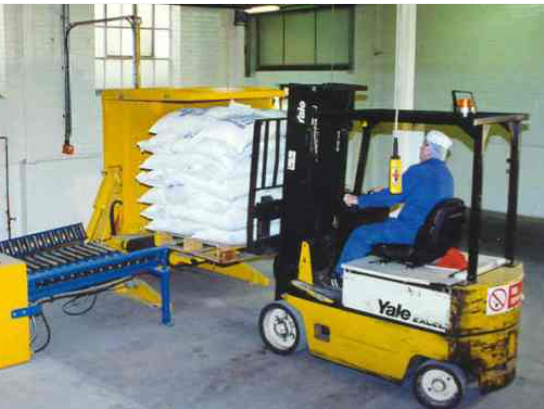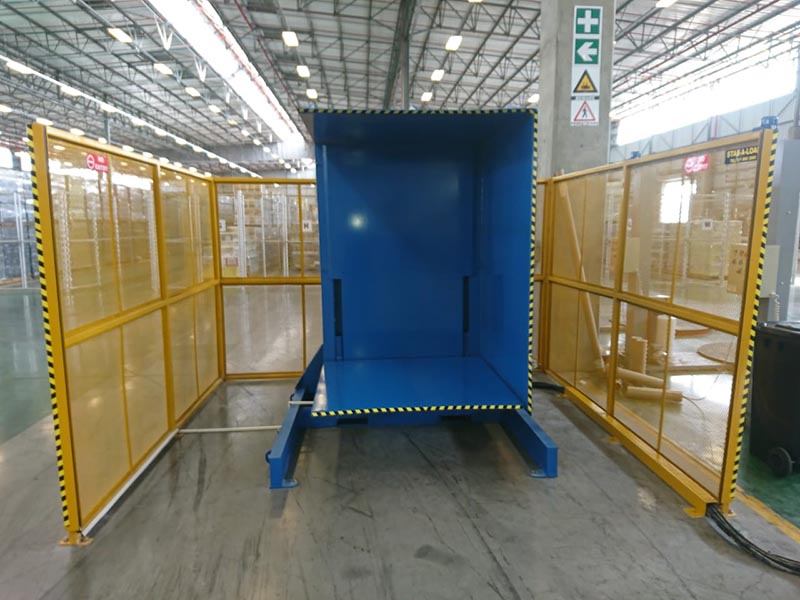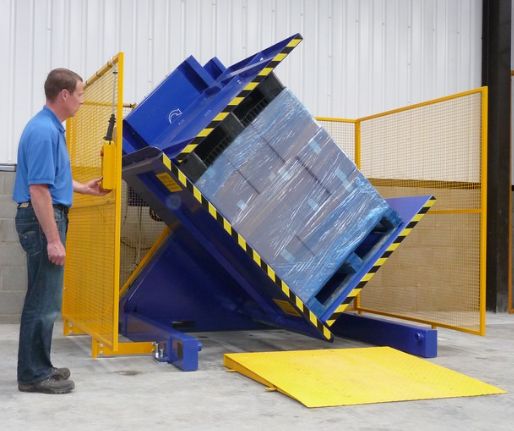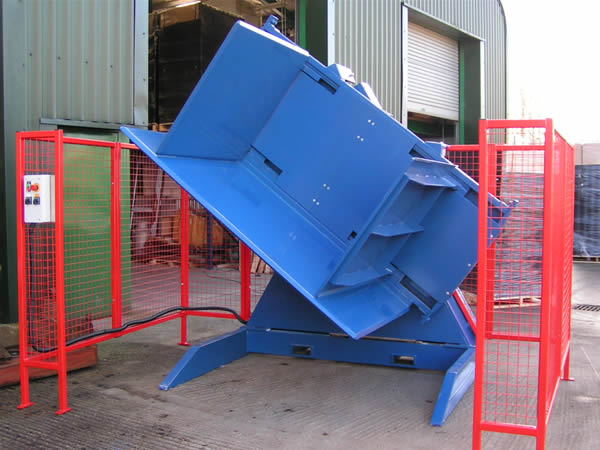From Manual to Smart: Pallet Inverters Transforming Turkey's Material Handling
Are you constantly dealing with the high costs and risks of manual material handling? In warehouses and factories, damaged goods from clumsy transfers, slow pallet exchange processes, and the persistent threat of worker injury are daily struggles. These issues are not just minor annoyances. They directly harm your bottom line. Every minute your team spends manually restacking a load is a minute lost from productive work. Every damaged product is a direct loss of revenue. And every potential injury carries the risk of costly claims and a drop in team morale. But there is a smarter, more efficient way. A wave of transformation is sweeping through industrial hubs like Turkey, driven by a powerful yet simple technology: the pallet inverter.
Pallet inverters are transforming material handling in Turkey by replacing slow, dangerous, and labor-intensive manual processes with a fast, automated, and secure solution. These machines allow businesses to quickly switch pallets to meet export standards, salvage goods from broken pallets, and improve overall warehouse logistics, leading to significant gains in efficiency, safety, and profitability.

I’ve spent my entire career in the packaging machine industry. I started on the factory floor and eventually built my own company, SHJLPACK. Along the way, I’ve seen firsthand how small changes in process can lead to massive improvements in output and safety. The shift from manual handling to automated solutions is one of the most impactful changes I've witnessed. It’s a journey I’ve helped many clients navigate, and it’s a story of progress that is especially visible in dynamic industrial markets like Turkey. Let’s explore how this technology works and why it’s becoming an essential tool for modern businesses.
What Exactly is a Pallet Inverter and How Does it Work?
Does the term "pallet inverter" sound like complex, intimidating industrial jargon? Many factory owners I speak with are so focused on their core production lines that they overlook the potential of auxiliary equipment. They see their current manual methods as "good enough," failing to realize the hidden costs of inefficiency and the risks they carry. The truth is, sticking with outdated manual processes is a liability, and understanding the alternative is the first step toward a major upgrade in your operations.
A pallet inverter is a stationary or mobile machine designed to securely clamp a fully loaded pallet, rotate it 180 degrees, and allow for the easy replacement of the pallet underneath. The process is simple: a forklift places the load into the inverter, the machine's clamps secure the product from the top and sides, it rotates the entire load upside down, and the original pallet can then be easily removed from the top. A new pallet is placed on top, and the machine rotates back, setting the load gently onto its new base.

To truly grasp its value, it’s important to look closer at the mechanics and the different forms this technology can take. It’s not a one-size-fits-all solution. The right machine depends entirely on your specific needs, a lesson I learned early in my engineering career when a client's "standard" solution failed because their product was unique.
The Core Mechanical Process
The genius of the pallet inverter lies in its simple, robust design that executes a few key actions flawlessly:
- Loading: The process begins when a forklift or conveyor places the entire palletized load into the inverter's bay.
- Clamping: Hydraulic or electric-powered pressure walls move inward to secure the load. The pressure is carefully calibrated to hold the product firmly without causing damage. The top clamp is crucial, as it secures the top layer of goods during inversion.
- Inverting (Rotation): A powerful motor drives the rotation of the clamping mechanism. Most models perform a full 180-degree rotation. This movement is smooth and controlled to prevent any shifting of the load.
- Pallet Exchange: Once inverted, the original pallet is now on top of the load, free to be lifted off. A new pallet (e.g., a plastic sanitary pallet, a rental pallet, or an export-compliant heat-treated pallet) is placed onto the load.
- Returning: The machine rotates back 180 degrees, gently lowering the product onto the new pallet. The clamps release, and the newly palletized load is ready for removal.
Types of Pallet Inverters
Not all inverters are the same. They are designed for different applications, speeds, and load types. Choosing the right one is critical.
| Inverter Type | Primary Use Case | Key Feature | Ideal For |
|---|---|---|---|
| Freestanding 180° Inverter | All-purpose pallet exchange | Rotates a full 180 degrees. Loaded by forklift. | General warehousing, recovering damaged goods, switching to plastic pallets. |
| In-line Conveyor Inverter | Fully automated lines | Integrates directly into a conveyor system. | High-volume production facilities, food and beverage, pharmaceuticals. |
| 90° Tipper (Load Exchanger) | Transferring stable loads | Tilts the load 90 degrees to slide it from one pallet to another. | Bagged goods (cement, grain), boxed products that are very stable. |
| Freezer Spacer Inverter | Food processing | Designed to insert or remove freezer spacers between layers of boxed goods. | Cold storage facilities, meat and poultry processing plants. |
| Mobile Pallet Changer | Low volume, multi-location use | A self-propelled unit that can move around the warehouse. | Facilities where a fixed installation is not practical; lower throughput needs. |
I remember a project for a client in the food industry. They needed to remove freezer spacers from thousands of pallets of frozen goods daily. A standard inverter was too slow. We worked with them to design a specialized inverter that could handle the specific dimensions of their boxes and spacers. That experience taught me that a deep understanding of the client's workflow is just as important as the engineering of the machine itself.
Why Are Turkish Businesses Embracing Pallet Inverter Technology?
Are you feeling the pressure of a globalized market? For many businesses, especially in export-driven economies like Turkey, competition is fierce. They must operate faster, leaner, and smarter to survive. Sticking with traditional, labor-intensive methods for tasks like material handling is no longer a viable option. It creates bottlenecks, increases costs, and can even disqualify them from certain international markets. This is the very challenge that is pushing Turkish companies to seek out and adopt transformative technologies.
Turkish businesses are rapidly adopting pallet inverter technology as a strategic move to boost competitiveness. They are using these machines to increase operational speed, slash labor costs, dramatically improve worker safety, and, crucially, comply with the strict ISPM 15 international shipping standards that require specific wood pallet treatments. This adoption is not a luxury; it's a necessary evolution to thrive in today's demanding market.

The situation in Turkey provides a powerful case study for any industrial business owner, whether you are in Mexico City, Mumbai, or Chicago. The economic forces and operational challenges are universal. Looking at why Turkish companies are making this shift can provide a clear roadmap for your own facility’s modernization.
The Economic and Logistical Drivers
Turkey has a unique geographic position, acting as a bridge between Europe and Asia. This has made it a major hub for manufacturing and logistics. However, this advantage comes with immense pressure to be highly efficient.
- Export-Oriented Economy: A huge portion of Turkey's industrial output is destined for the European Union and other global markets. These markets have strict regulations, including ISPM 15, which dictates that wood packaging material must be heat-treated or fumigated to prevent the spread of pests. Pallet inverters allow companies to easily transfer goods from internal, low-cost wooden pallets to certified, export-ready pallets right before shipping.
- Rising Labor Costs: While historically an advantage, labor costs in Turkey are on the rise. Automating tasks like pallet switching, which can take two workers 15-20 minutes to do manually, frees up valuable personnel for more skilled tasks. A pallet inverter does the same job in under two minutes with one operator.
- Focus on Quality and Speed: To compete with giants in Europe and Asia, Turkish companies must deliver high-quality goods quickly. Pallet inverters help maintain product integrity. Manual restacking often leads to damaged boxes, scuffed labels, and unstable loads. The controlled, gentle motion of an inverter protects the product, ensuring it arrives at the customer in perfect condition.
Strategic Advantages Realized by Turkish Companies
For a pragmatic business owner like my client Javier in Mexico, numbers and clear benefits are everything. The same is true for his counterparts in Turkey. They are not investing in technology for its own sake; they are investing in tangible results.
Here’s a comparison that illustrates the stark difference between the old way and the new way in a typical Turkish export scenario:
| Metric | Manual Pallet Exchange | Using a Pallet Inverter | Strategic Advantage |
|---|---|---|---|
| Time per Pallet | 15 - 20 minutes | < 2 minutes | Massive Throughput Increase |
| Labor Required | 2 workers | 1 operator (forklift driver) | Over 50% Labor Reduction |
| Product Damage Risk | High (dropping, crushing) | Very Low | Improved Quality & Reduced Waste |
| Worker Safety Risk | High (back strain, repetitive motion) | Minimal | Lower Injury Rates & Insurance Costs |
| ISPM 15 Compliance | Slow, cumbersome process | Fast, integrated step | Unlocks Export Market Access |
I once visited a client's facility in Istanbul. They manufactured automotive parts for export to Germany. Their biggest bottleneck was the final packaging stage. Manually switching to Euro-pallets was causing shipping delays and occasional product damage. After installing a simple, freestanding pallet inverter, they cleared their backlog within a week. The plant manager told me it was the best investment they had made all year. It didn't just solve a logistics problem; it gave them the confidence to bid on larger, more demanding contracts.
How Do Pallet Inverters Boost Operational Efficiency and Safety?
Is your facility's efficiency being silently drained by outdated processes? Are you worried about the constant risk of workplace injuries and the associated costs? These are two of the biggest concerns for any hands-on owner or manager. The pressure to increase output while ensuring a safe environment is immense. A solution that tackles both of these challenges simultaneously isn't just helpful; it's a game-changer for your entire operation.
Pallet inverters directly boost operational efficiency by slashing the time required to handle pallet-related tasks from many minutes to mere seconds. Simultaneously, they enhance safety by completely removing the need for manual lifting and restacking, which is a leading cause of musculoskeletal injuries in industrial environments. This dual benefit creates a faster, safer, and more productive workflow.

Throughout my career, I've seen many factories that are highly optimized in their core production but neglect the "in-between" processes like material handling. It’s like having a high-performance engine connected to a rusty transmission. The whole system underperforms. Let's break down exactly how an inverter fine-tunes that transmission for maximum performance and reliability.
A Deep Dive into Efficiency Gains
Efficiency in a manufacturing or logistics setting is about flow. Anything that interrupts or slows down the movement of goods is a bottleneck that costs money. Pallet inverters eliminate some of the most common bottlenecks.
- Cycle Time Reduction: Consider the task of recovering a damaged pallet at the bottom of a stack. Manually, workers have to de-stack every single box or bag, set them aside, replace the pallet, and then re-stack the entire load. This can take up to 20 minutes and brings a section of your warehouse to a standstill. A pallet inverter accomplishes this in under two minutes. For a facility that handles hundreds of pallets a day, this time saving is astronomical. It translates directly into higher throughput and increased capacity without adding a single new production machine.
- Streamlining Workflows: Pallet inverters can be placed at strategic points—receiving, warehousing, and shipping—to streamline operations.
- At Receiving: Immediately transfer incoming goods from potentially low-quality supplier pallets to high-quality internal pallets. This prevents poor pallets from entering and disrupting your automated systems.
- In Production: Switch to captive or sanitized pallets required for specific cleanroom or food-grade production zones.
- At Shipping: Quickly transfer finished goods to export-compliant, customer-specific, or rental pallets just before loading. This "just-in-time" palletizing reduces the need to store goods on expensive specialty pallets.
The Unseen ROI: Enhanced Workplace Safety
While the efficiency gains are easy to see on a stopwatch, the safety benefits provide a powerful, long-term return on investment. Manual handling of heavy, repetitive loads is a primary cause of workplace injuries.
- Ergonomics and Injury Prevention: The act of bending, lifting, and twisting to restack a pallet is an ergonomic nightmare. It leads to back strains, shoulder injuries, and repetitive stress disorders. These are among the most common and costly workers' compensation claims. A pallet inverter removes this physical burden entirely. The operator can stay safely within the forklift cab or at a control panel.
- Reducing Secondary Risks: Manual de-stacking can create unstable temporary stacks of products on the floor, posing a tripping or toppling hazard to other workers in the area. By containing the product within the inverter during the entire process, these secondary risks are eliminated.
Let's quantify this with a simple ROI analysis. For a business owner like Javier, who aims to cut operational costs by 8%, this is where the real value becomes clear.
| ROI Factor | Manual Method Cost | Pallet Inverter Benefit | Financial Impact |
|---|---|---|---|
| Labor | 2 workers x 20 min = 40 min/pallet | 1 operator x 2 min = 2 min/pallet | 95% reduction in labor time per task |
| Product Damage | Avg. 1-3% damage rate from handling | <0.1% damage rate | Significant reduction in written-off inventory |
| Worker Injury | High risk of claims ($10k-$40k avg.) | Very low risk | Lower insurance premiums, no lost workdays |
| Throughput | 3-4 pallets/hour/team | 30+ pallets/hour/machine | Unlocks higher production/shipping capacity |
The numbers speak for themselves. This isn't just about buying a new piece of equipment. It's about fundamentally re-engineering a core process for greater efficiency, safety, and profitability.
What Are the Key Considerations When Choosing a Pallet Inverter?
Are you thinking about investing in a pallet inverter but feel overwhelmed by the options? Making a significant capital investment can be daunting. Choosing the wrong machine for your specific application can lead to buyer's remorse, operational disruptions, and a solution that doesn't deliver the expected return. You need more than just a supplier; you need a partner who can help you analyze your needs and select the perfect fit.
When choosing a pallet inverter, the key considerations are your specific load characteristics (weight, dimensions, fragility), your required throughput (cycles per hour), the level of automation that fits your workflow (standalone or in-line), and the reputation of the supplier for service and support. Getting these factors right is crucial for a successful implementation.

I've built my business, SHJLPACK, on the principle of being a total solution provider. This means my job doesn't end when a machine is sold. It begins with helping the client understand their own process. Over the years, I've developed a simple framework to guide clients through the selection process. Let's walk through it. It’s about asking the right questions before you even look at a single brochure.
Assessing Your Load Characteristics
The product you are handling is the single most important factor. The machine must be built to handle your load, not the other way around.
- Weight and Dimensions: What is the maximum weight of your loaded pallets? What are the length, width, and height of your tallest and widest loads? You need an inverter with a capacity that exceeds your heaviest load for a safety margin. The opening range of the clamps must accommodate your full range of load sizes.
- Product Type and Stability: Are you handling robust, stable boxes? Or are you handling fragile glass bottles, shifty bags of powder, or heavy steel coils? The clamping pressure and mechanism need to be appropriate. For very sensitive loads, pressure-regulating sensors are essential. For unstable loads, side-support walls are non-negotiable. I have specific expertise in coil packing, and I know that inverting a 2-ton steel coil requires a completely different level of engineering than inverting a pallet of potato chips.
- Special Considerations: Do you operate in a sanitary environment like food or pharma? You will need a stainless steel or powder-coated "clean machine" design. Do you work in explosive environments? You’ll require an explosion-proof (ATEX) certified model.
Matching the Machine to Your Workflow
How and where the machine will be used determines the level of automation you need.
- Standalone vs. Integrated: A standalone, forklift-loaded inverter is perfect for lower-volume applications or when you need flexibility in placement. It's the simplest and most common configuration. An in-line, conveyor-fed inverter is for high-volume, fully automated production lines where the pallet transfer needs to happen without any human intervention. This is a more complex and expensive system but essential for maximizing throughput in large-scale operations.
- Cycles Per Hour: Be realistic about your needs. How many pallets do you truly need to invert per hour during peak times? Don't over-invest in a high-speed model if your workflow can't keep up with it. Conversely, don't buy a machine that will become a new bottleneck. A good supplier will help you calculate your required throughput.
Beyond the Machine: The Importance of a True Partner
This is the point I stress most with my clients. The machine itself is only half of the solution. The company you buy from is the other half. This is especially true for an owner like Javier, who seeks strategic partnerships.
| Selection Criteria | What to Look For in a Supplier | Why It Matters |
|---|---|---|
| Consultation | Do they ask deep questions about your process or just try to sell you a standard model? | A true partner seeks to understand your problem before offering a solution. |
| Installation & Training | Do they offer on-site installation, commissioning, and operator training? | Proper setup and training are essential for safety and maximizing machine life. |
| After-Sales Support | What is their spare parts availability? Do they have technicians who can provide support? | When a machine is down, you need a responsive partner to get you running again quickly. |
| Customization | Are they willing and able to make modifications for your unique needs? | Proves they have deep engineering expertise, not just sales knowledge. |
Making the right choice is a process of careful analysis. It's a collaboration between your internal team, who knows your product and workflow, and an experienced machine provider who knows the technology inside and out.
Conclusion
Pallet inverters are more than machines; they are a strategic step towards a smarter, safer, and more profitable material handling operation for any modern industrial business.





